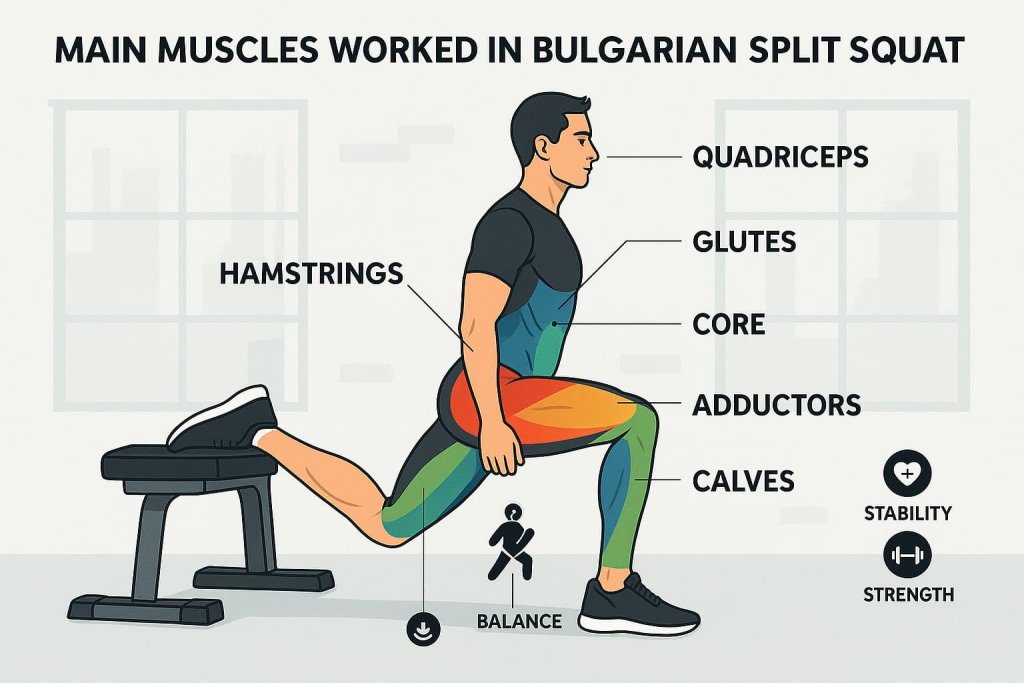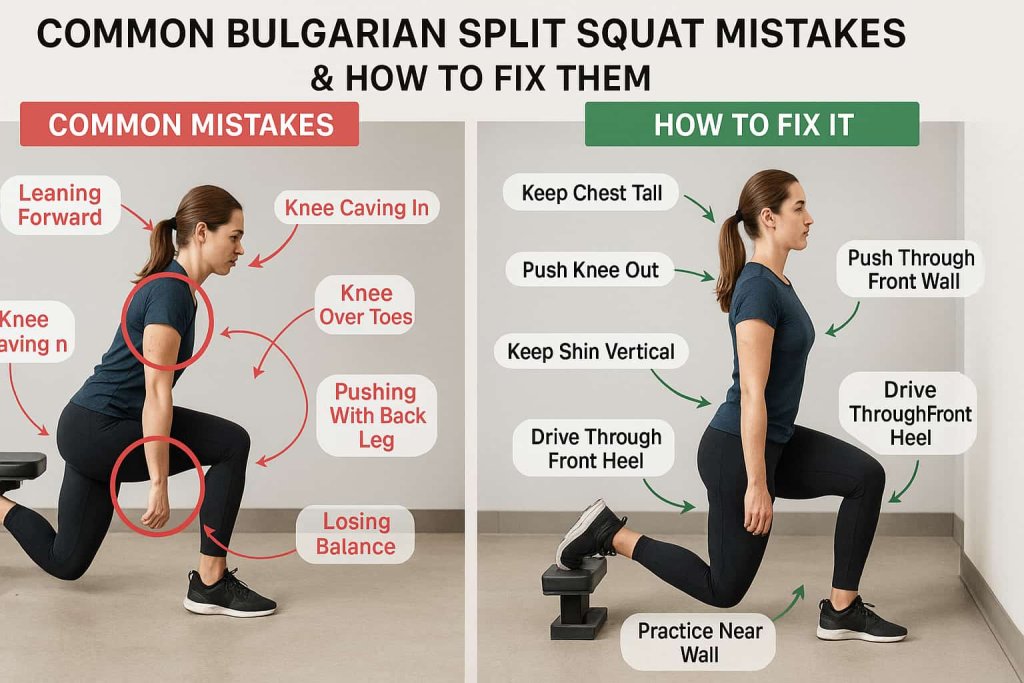The Bulgarian split squat is a powerful single-leg exercise that targets your quads, glutes, and core for maximum strength, muscle, and balance. If you want to build athletic legs, improve lower body stability, and fix muscle imbalances, this is the movement you need in your routine. The key to success is performing it with perfect form and progressing safely.

Why is this important? The Bulgarian split squat (also called rear-foot elevated split squat) not only enhances muscle and strength but also helps reduce injury risk by training each leg independently. This guide will walk you through every step—form, benefits, mistakes to avoid, variations, programming tips, and answers to the most common questions—so you can perform it like a pro.
- Simple setup at home or in the gym
- Huge benefits for muscle, strength, and balance
- Suitable for all levels—beginner to advanced
- Minimal equipment required
- Learn how to avoid injuries and common errors
What Is a Bulgarian Split Squat?
A Bulgarian split squat is a lower-body exercise where you squat down on one leg while your other foot rests elevated behind you (usually on a bench). The result? High levels of tension on your working leg, huge muscle-building stimulus, and improved coordination and balance.
Why choose it over regular squats or lunges?
- It develops unilateral strength—training one leg at a time prevents your stronger leg from dominating.
- Less pressure on your lower back than barbell squats.
- Improves hip mobility and ankle stability.
- Builds functional strength for sports and daily movement.
Proper Form: Step-by-Step Instructions
- Setup:
- Stand with your back to a bench or sturdy step (about knee height).
- Place the top of your rear foot (laces down) on the bench.
- Position your front foot about two feet in front of the bench (distance may vary by your height—test and adjust).
- Start Position:
- Stand tall with your chest up, shoulders back, and core braced.
- Your front knee and ankle should be stacked, not caving in or traveling far past your toes.
- Descent:
- Inhale, keep your torso upright or slightly leaning forward, and bend your front knee to lower your body.
- Lower your hips straight down—not forward—until your front thigh is parallel to the ground and your back knee is hovering 1–2 inches above the floor.
- Keep most of your weight on your front heel.
- Push Up:
- Exhale and drive through your front heel, straightening your leg to return to the starting position.
- Keep your chest high and hips level.
- Repetitions:
- Complete all reps on one side, then switch legs.
Pro Trainer Tips:
- Hold dumbbells at your sides for added resistance as you progress.
- Keep your core engaged at all times to prevent leaning or arching your lower back.
- If you lose balance, try lowering the bench or practicing near a wall for support.
Muscles Worked and Science-Backed Benefits

Main Muscles Worked
- Quadriceps (front thigh)
- Glutes (butt)
- Hamstrings
- Core muscles (for stability)
- Adductors (inner thigh)
- Calves (to a smaller degree)
Why It’s Effective
- Maximal Quad and Glute Activation: EMG studies show the Bulgarian split squat targets both the quads and glutes more than traditional split squats or lunges (Strength & Conditioning Journal, 2024).
- Unilateral Training: Prevents muscle imbalances by forcing each leg to work independently.
- Improved Mobility: The rear-foot elevation opens your hips and improves lower body flexibility.
- Better Core Strength: Stabilizing on one leg increases core muscle recruitment.
- Functional Strength: Mimics real-life movements (climbing stairs, sports, running).
Additional Benefits
- Less spinal compression vs. barbell squats
- Can be done almost anywhere (no squat rack required)
- Scalable for all fitness levels
Common Mistakes and How to Fix Them

| Mistake | Why It’s a Problem | How to Fix It |
|---|---|---|
| Leaning forward or arching back | Puts strain on lower back; reduces quad/glute activation | Keep chest tall, spine neutral, and core tight |
| Knee caving in (“valgus collapse”) | Increases knee injury risk | Push knee out, keep in line with toes |
| Front knee traveling too far past toes | Excessive knee stress | Adjust stance; keep shin vertical at bottom |
| Using rear leg to push up | Reduces effectiveness for working leg | Drive through front heel, let back leg “go along for the ride” |
| Losing balance | Wastes reps, risk of injury | Slow down, focus on control, practice near wall if needed |
Trainer Fixes:
- Video your form from the side and front—check that your knee and torso stay aligned.
- If you struggle with balance, shorten your range of motion until you build strength.
Bulgarian Split Squat Variations for All Levels
The Bulgarian split squat is a top-tier single-leg exercise that builds strength, stability, and muscle in your legs and glutes. Its many variations mean anyone—from beginners to elite athletes—can find the perfect progression. Here’s a detailed breakdown of each variation, plus coaching tips and programming advice.
1. Bodyweight Bulgarian Split Squat
Who is it for?
Beginners and anyone learning the movement.
How to Do It:
- Stand about 2 feet in front of a bench or sturdy chair.
- Place one foot behind you on the bench (shoelaces down).
- Keep your chest tall, core tight, and hands on your hips or in front of you for balance.
- Lower your back knee toward the ground, bending your front knee to about 90°.
- Push through your front heel to stand back up.
Why It Matters:
- Teaches balance and single-leg strength.
- Perfects your movement pattern before adding load.
Common Mistakes:
- Letting the front knee cave inward or travel far past the toes.
- Leaning the torso forward.
- Not keeping the back foot relaxed.
Trainer Tip:
Start with a short range of motion if you’re new. Gradually increase your depth as you get stronger and more flexible.
2. Dumbbell Bulgarian Split Squat
Who is it for?
Intermediate lifters with good balance and form.
How to Do It:
- Get into position as above, but hold a dumbbell in each hand, arms straight at your sides.
- Keep your core braced and shoulders pulled back.
- Lower under control, then drive up powerfully.
Benefits:
- Adds resistance to boost muscle growth and strength.
- Engages grip, forearms, and upper back for stabilization.
Trainer Tip:
Don’t let the dumbbells swing! Move smoothly and maintain control throughout.
3. Barbell Bulgarian Split Squat
Who is it for?
Advanced trainees seeking to maximize strength.
How to Do It:
- Set up a barbell in a squat rack, unrack it onto your upper back (as in a back squat).
- Carefully step into position, elevate your rear foot, and perform the squat.
- Use a spotter or safety bars if you’re going heavy.
Benefits:
- Allows for heavier loading compared to dumbbells.
- Greater challenge for the core and stabilizers.
Trainer Tip:
Start with just the bar until your balance and technique are dialed in. Always set the bar at a comfortable height for untracking/retracking.
4. Front-Foot Elevated Bulgarian Split Squat
Who is it for?
Intermediate to advanced, especially if you want more stretch or mobility.
How to Do It:
- Stand with your front foot on a small step (2–4 inches).
- Elevate your back foot as usual.
- Lower down, letting your back knee sink deeper.
Benefits:
- Increases hip and quad stretch.
- Greater range of motion for more muscle activation.
Trainer Tip:
Don’t let your torso lean forward—stay upright. Go slow to feel the stretch, especially at the bottom.
5. Deficit Bulgarian Split Squat
Who is it for?
Advanced lifters looking for a mobility and strength challenge.
How to Do It:
- Place your front foot on a step/platform and your back foot on an elevated surface (bench/chair).
- Perform the split squat, going deeper than usual.
Benefits:
- Maximizes range of motion and flexibility.
- Targets stabilizers and weak points.
Trainer Tip:
Only try if you’re strong and stable with regular and front-foot elevated versions. Lower under full control.
6. Paused or Pulse Rep Bulgarian Split Squat
Who is it for?
Anyone wanting more muscle tension and burn.
How to Do It:
- At the bottom of the squat, pause for 1–3 seconds.
- Or, add 3–5 small pulses (tiny up-and-down movements) before standing up.
Benefits:
- Increases time under tension—key for muscle growth.
- Builds isometric strength at the hardest part of the movement.
Trainer Tip:
No bouncing! Move with control to protect your knees and maximize results.
7. Goblet Bulgarian Split Squat
Who is it for?
All levels, great for learning to brace your core and maintain posture.
How to Do It:
- Hold a dumbbell or kettlebell at your chest (goblet style).
- Perform the split squat as usual.
Benefits:
- Teaches good posture and upright torso.
- Adds a core stability challenge.
Trainer Tip:
Keep elbows tucked and abs braced. If you round your back, use a lighter weight.
Progression & Pro Tips
Rest between sets: Allow 60–90 seconds for recovery and best strength output.ng load. Try tempo reps (3 seconds down, 1–2 seconds pause at bottom, explosive up) for even greater results.
Master bodyweight before adding load. Aim for 10–15 perfect reps per side.
Add weight slowly: Progress to dumbbells, then kettlebells or a barbell.
Use tempo reps: Lower for 3 seconds, pause at the bottom, then push up fast.
Switch variations: Try a different style every week to work new muscles and prevent plateaus.
Warm up well: Mobilize hips and ankles before starting.
How to Add Bulgarian Split Squats to Your Routine
- Beginner: 2–3 sets of 8–12 reps per leg, 1–2 times per week
- Intermediate/Advanced: 3–4 sets of 8–15 reps per leg, progress to dumbbells/barbell as strength improves
- Where in Your Workout? After big compound lifts (squats, deadlifts) or as your main single-leg exercise
- Rest: 1–2 minutes between sets
Sample Leg Day Example:
- Barbell back squat (main lift)
- Romanian deadlift or leg curl
- Bulgarian split squat (3×10/leg)
- Calf raises or glute bridges
Trainer’s Programming Tips: Focus on form, not weight. Don’t rush your progression—bodyweight first, then dumbbells, then barbell. Always warm up your hips, knees, and ankles.
FAQs and Instructor Answers
1. Should my back knee touch the floor?
No—keep it hovering 1–2 inches above the ground for safety and constant muscle tension.
2. How do I know my stance is correct?
When you lower down, your front shin should be vertical, and your knee shouldn’t pass your toes. Adjust foot position as needed.
3. What if I lose balance?
Reduce range of motion, try holding onto a stable object, or keep your bench a bit lower until you build stability.
4. Can I do these if I have knee pain?
Try a shorter range of motion, elevate the front foot, or focus on hip-dominant versions. If pain persists, stop and consult a professional.
5. Are Bulgarian split squats better than regular squats?
They’re different! Bulgarian split squats are better for single-leg strength and correcting imbalances, but regular squats allow for heavier weights and more overall muscle loading.
Conclusion
Mastering the Bulgarian split squat is a game-changer for lower body strength, balance, and injury prevention. With perfect form and progressive overload, you’ll see real results in muscle and athleticism—whether you’re a beginner or advanced.
